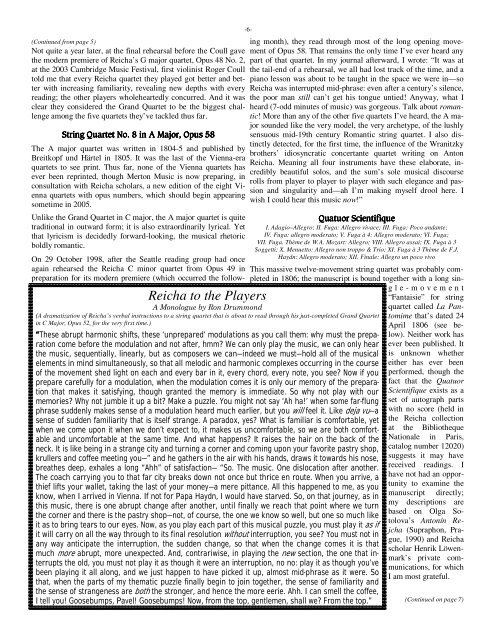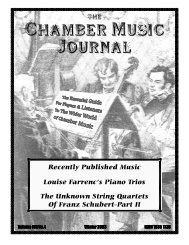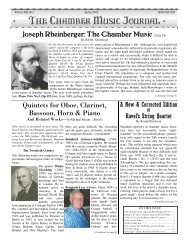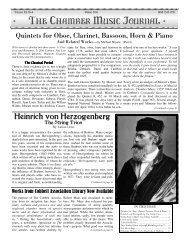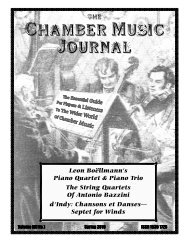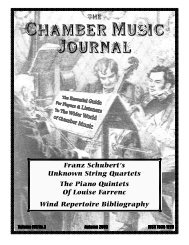Create successful ePaper yourself
Turn your PDF publications into a flip-book with our unique Google optimized e-Paper software.
(Continued from page 5)Not quite a year later, at the final rehearsal before the Coull gavethe modern premiere of Reicha’s G major quartet, Opus 48 No. 2,at the 2003 Cambridge Music Festival, first violinist Roger Coulltold me that every Reicha quartet they played got better and betterwith increasing familiarity, revealing new depths with everyreading; the other players wholeheartedly concurred. And it wasclear they considered the Grand Quartet to be the biggest challengeamong the five quartets they’ve tackled thus far.String Quartet No. 8 in A Major, Opus 58The A major quartet was written in 1804-5 and published byBreitkopf und Härtel in 1805. It was the last of the Vienna-eraquartets to see print. Thus far, none of the Vienna quartets hasever been reprinted, though Merton Music is now preparing, inconsultation with Reicha scholars, a new edition of the eight Viennaquartets with opus numbers, which should begin appearingsometime in 2005.Unlike the Grand Quartet in C major, the A major quartet is quitetraditional in outward form; it is also extraordinarily lyrical. Yetthat lyricism is decidedly forward-looking, the musical rhetoricboldly romantic.-6-On 29 October 1998, after the Seattle reading group had onceagain rehearsed the Reicha C minor quartet from Opus 49 inpreparation for its modern premiere (which occurred the followingmonth), they read through most of the long opening movementof Opus 58. That remains the only time I’ve ever heard anypart of that quartet. In my journal afterward, I wrote: “It was atthe tail-end of a rehearsal, we all had lost track of the time, and apiano lesson was about to be taught in the space we were in—soReicha was interrupted mid-phrase: even after a century’s silence,the poor man still can’t get his tongue untied! Anyway, what Iheard (7-odd minutes of music) was gorgeous. Talk about romantic!More than any of the other five quartets I’ve heard, the A majorsounded like the very model, the very archetype, of the lushlysensuous mid-19th century Romantic string quartet. I also distinctlydetected, for the first time, the influence of the Wranitzkybrothers’ idiosyncratic concertante quartet writing on AntonReicha. Meaning all four instruments have these elaborate, incrediblybeautiful solos, and the sum’s sole musical discourserolls from player to player to player with such elegance and passionand singularity and—ah I’m making myself drool here. Iwish I could hear this music now!”Quatuor ScientifiqueI. Adagio–Allegro; II. Fuga: Allegro vivace; III. Fuga: Poco andante;IV. Fuga: allegro moderato; V. Fuga à 4: Allegro moderato; VI. Fuga;VII. Fuga. Thème de W.A. Mozart: Allegro; VIII. Allegro assai; IX. Fuga à 3Soggetti; X. Menuetto: Allegro non troppo & Trio; XI. Fuga à 3 Thème de F.J.Haydn: Allegro moderato; XII. Finale: Allegro un poco vivoReicha to the PlayersA Monologue by Ron Drummond(A dramatization of Reicha’s verbal instructions to a string quartet that is about to read through his just-completed Grand Quartetin C Major, Opus 52, for the very first time.)“These abrupt harmonic shifts, these ‘unprepared’ modulations as you call them: why must the preparationcome before the modulation and not after, hmm? We can only play the music, we can only hearthe music, sequentially, linearly, but as composers we can—indeed we must—hold all of the musicalelements in mind simultaneously, so that all melodic and harmonic complexes occurring in the courseof the movement shed light on each and every bar in it, every chord, every note, you see? Now if youprepare carefully for a modulation, when the modulation comes it is only our memory of the preparationthat makes it satisfying, though granted the memory is immediate. So why not play with ourmemories? Why not jumble it up a bit? Make a puzzle. You might not say ‘Ah ha!’ when some far-flungphrase suddenly makes sense of a modulation heard much earlier, but you will feel it. Like deja vu—asense of sudden familiarity that is itself strange. A paradox, yes? What is familiar is comfortable, yetwhen we come upon it when we don’t expect to, it makes us uncomfortable, so we are both comfortableand uncomfortable at the same time. And what happens? It raises the hair on the back of theneck. It is like being in a strange city and turning a corner and coming upon your favorite pastry shop,krullers and coffee meeting you—” and he gathers in the air with his hands, draws it towards his nose,breathes deep, exhales a long “Ahh” of satisfaction— “So. The music. One dislocation after another.The coach carrying you to that far city breaks down not once but thrice en route. When you arrive, athief lifts your wallet, taking the last of your money—a mere pittance. All this happened to me, as youknow, when I arrived in Vienna. If not for Papa Haydn, I would have starved. So, on that journey, as inthis music, there is one abrupt change after another, until finally we reach that point where we turnthe corner and there is the pastry shop—not, of course, the one we know so well, but one so much likeit as to bring tears to our eyes. Now, as you play each part of this musical puzzle, you must play it as ifit will carry on all the way through to its final resolution without interruption, you see? You must not inany way anticipate the interruption, the sudden change, so that when the change comes it is thatmuch more abrupt, more unexpected. And, contrariwise, in playing the new section, the one that interruptsthe old, you must not play it as though it were an interruption, no no: play it as though you’vebeen playing it all along, and we just happen to have picked it up, almost mid-phrase as it were. Sothat, when the parts of my thematic puzzle finally begin to join together, the sense of familiarity andthe sense of strangeness are both the stronger, and hence the more eerie. Ahh. I can smell the coffee,I tell you! Goosebumps, Pavel! Goosebumps! Now, from the top, gentlemen, shall we? From the top.”This massive twelve-movement string quartet was probably completedin 1806; the manuscript is bound together with a long singl e - m o v e m e n t“Fantaisie” for stringquartet called La Pantomimethat’s dated 24April 1806 (see below).Neither work hasever been published. Itis unknown whethereither has ever beenperformed, though thefact that the QuatuorScientifique exists as aset of autograph partswith no score (held inthe Reicha collectionat the BibliothequeNationale in Paris,catalog number 12020)suggests it may havereceived readings. Ihave not had an opportunityto examine themanuscript directly;my descriptions arebased on Olga Sotolova’sAntonín Rejcha(Supraphon, Prague,1990) and Reichascholar Henrik Löwenmark’sprivate communications,for whichI am most grateful.(Continued on page 7)


